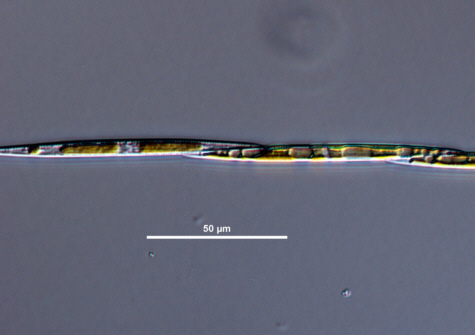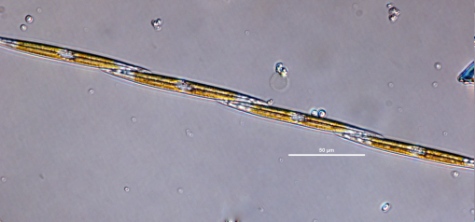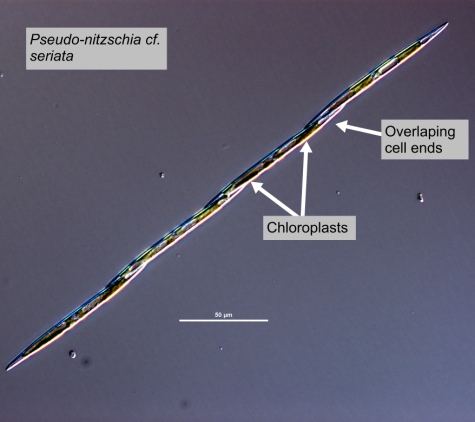



|
Synonym(s)
Basionym
The original name for an organism. In botany, the original published nomenclature from which a new binomial nomenclature is derived for a particular group of organisms (Tindall 1999).
(basionym, CloseHomotypic
Expressing the same fundamental type or structure; may or may not be symmetrical (e.g., the two valves of a diatom, where they are the same shape and appearance, but one is bigger than the other). In naming species, a homotypic synonym is one that comes into being when a taxon gets a new name (without being added to an already existing taxon).
homotypic)P. australis: Nitzschia pseudoseriata G. R. Hasle 1965 Close
Heterotypic
A difference in type. In naming species, a heterotypic synonym is one that comes into being when a taxon becomes part of a different taxon. Compare to homotypic.
(heterotypic)(Guiry and Guiry 2012)
Classification
(Guiry and Guiry 2012)
Lifestyle
Description
Apical
(axis, spine) The region of the apex or point. Refers to the most anterior point or region of the cell (HPP 2003).
apical axis. Central larger interspace is absent (visible only in EM; Hasle and Syvertsen 1997).SEM
(scanning electron microscope) A microscope which applies "a focused beam of high-energy electrons to generate a variety of signals at the surface of solid specimens" (NSF 2011).
SEM is not available, identify these wider (> 3 μm) species as "P. seriata complex".Measurements
Width Close
Transapical axis
In diatoms, the longitudinal axis of the valve.
(transapical axis): 3 - 8 μmClose
Striae
(referring to pores in diatoms) In diatoms, a striation or row of pores on the valve face. "In centric diatoms, striae may be radial, running from the centre of the valve to the margin ... In pennate diatoms, striae may be parallel to the median line of the valve or raphe" (Horner 2002).
Striae: 9 - 18 in 10 μmFibulae: 9 - 18 in 10 μm
(Hasle and Syvertsen 1997)
Similar species
Harmful effects
Habitat
Distribution
Cosmopolitan (Hasle and Syvertsen 1997).
Often forms blooms during the summer in Scottish waters (Fehling 2004).
Present throughout the summer in medium to low abundances.
Growth conditions
Environmental Ranges
Temperature range (°C): -1.186 - 29.365
Nitrate (μmol L-1): 0.056 - 8.291
Salinity: 31.845 - 36.252
Oxygen (mL L-1): 4.524 - 8.441
Phosphate (μmol L-1): 0.046 - 0.870
Close
Silicic acid
A general term to describe chemical compounds containing silicon, oxygen and hydrogen with a general formula of [SiOx(OH)4-2x]n. Diatoms polymerize silicic acid into biogenic silica to form their frustules (Azam and Chisholm 1976).
Silicate (μmol L-1): 0.754 - 16.912(OBIS 2012, cited in EOL 2012)
Bloom characteristics
References
Encyclopedia of Life (EOL). 2012. Pseudo-nitzschia. http://eol.org/pages/13279/overview. Accessed 17 Mar 2012.
Fehling, J. 2004. Diversity, ecology and domoic acid production of Pseudo-nitzschia spp. in Scottish waters. Ph.D. Dissertation. Open University, UK. 309.
Guiry, M. D. and Guiry, G. M. 2012. Pseudo-nitzschia H. Peragallo in H. & M. Peragallo, 1900: 263, 298. http://www.algaebase.org/search/genus/detail/?genus_id=44450. Accessed 17 Mar 2012.
Hasle, G. R. and Syvertsen, E. E. 1997. Marine diatoms. In: Tomas, C. R. (ed.) Identifying Marine Phytoplankton. Academic Press, Inc., San Diego. 5-385.
Horner, R. A. 2002. A Taxonomic Guide To Some Common Phytoplankton. Biopress Limited, Dorset Press, Dorchester, UK. 200.
Howard, M. D. A., Cochlan, W. P., Ladizinsky, N. and Kudela, R. M. 2007. Nitrogenous preference of toxigenic Pseudo-nitzschia australis (Bacillariophyceae) from field and laboratory experiments. Harmful Algae. 6: 206-217.
Ocean Biogeographic Information System (OBIS). 2012. Pseudo-nitzschia. http://www.iobis.org/mapper/?taxon_id=499390. Accessed 17 Mar 2012.
